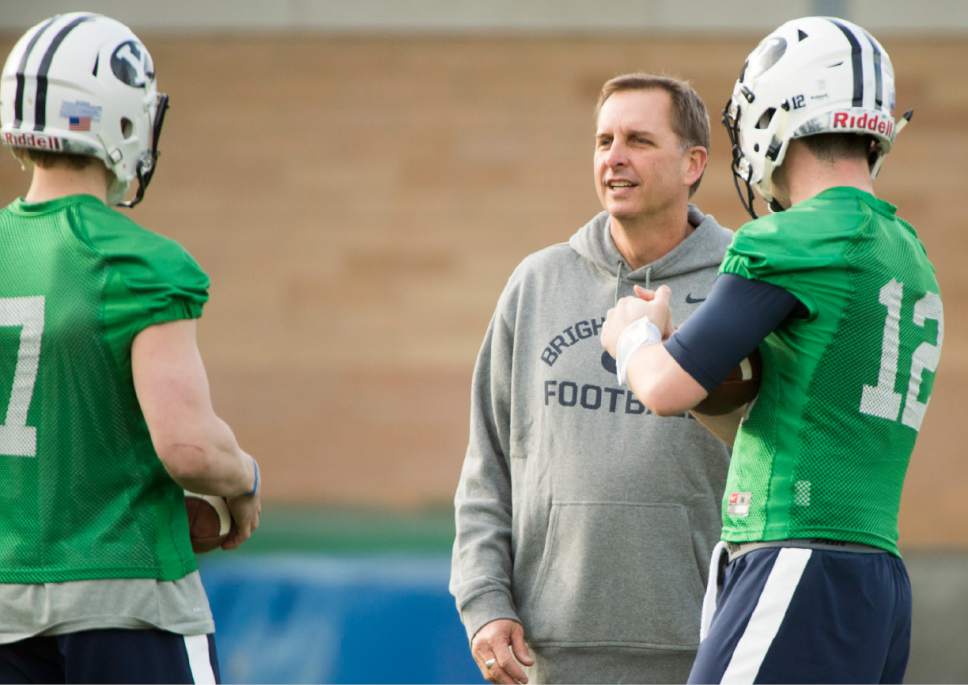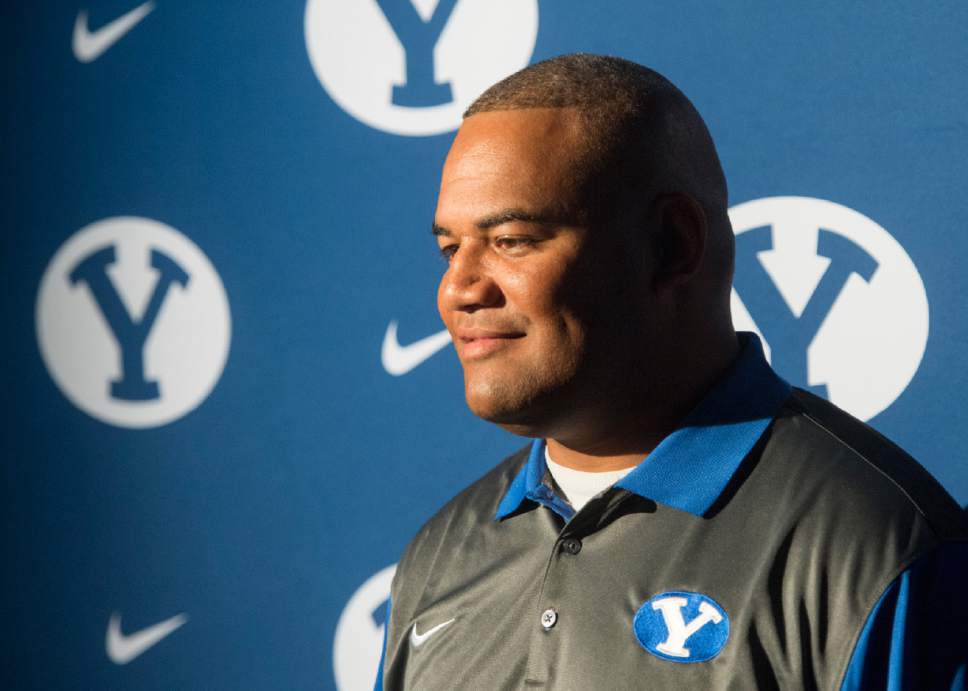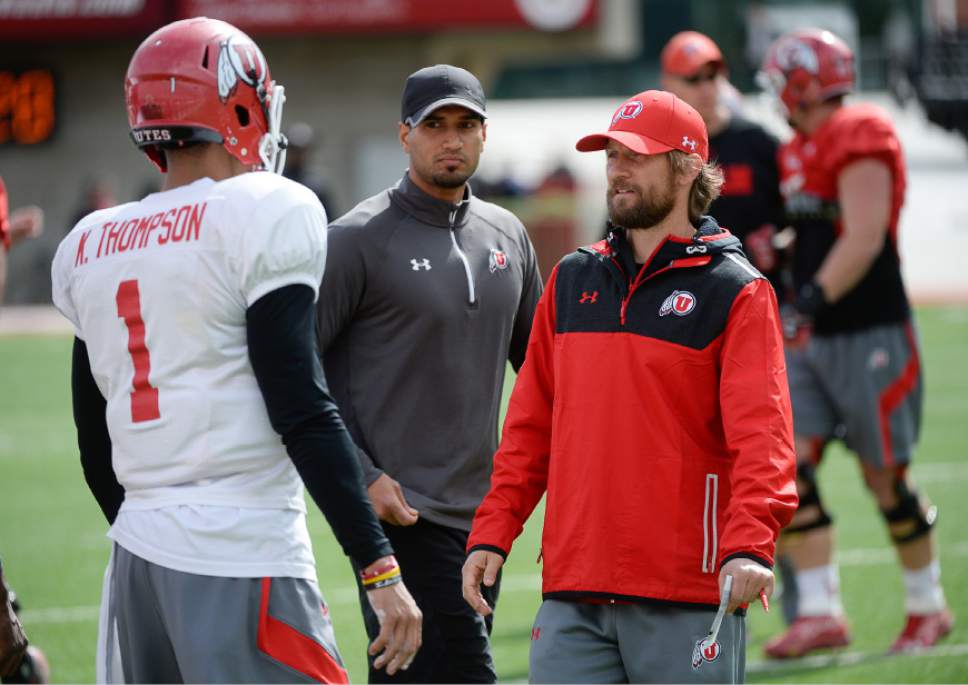This is an archived article that was published on sltrib.com in 2016, and information in the article may be outdated. It is provided only for personal research purposes and may not be reprinted.
Surprises? No.
When Kyle Whittingham watched BYU's final-minute victory over Arizona last weekend, he thought Cougar offensive coordinator Ty Detmer called a good game. Jamaal Williams ran well, Taysom Hill threw efficiently, and BYU's constant swapping of personnel kept Arizona off-balance.
But from a scheme perspective, what Whittingham saw was inherently familiar. He called it "similar to what I anticipated." Linebacker coach Justin Ena, a former BYU backer, said he saw a lot of it back when he was a player in practice.
"Watching BYU's offense right now, you see a lot from when we played the way [former BYU offensive coordinator] Norm Chow used to call it," Ena said. "I'm excited to play that on defense. It's kind of the old-school stuff where it's 21- or 22-personnel where they just pound the ball and make you stop them."
Watching the rivalry on Saturday evening will give fans a picture into two different branches from roughly the same tree on both sides of the ball. While Utah and BYU run different offensive and defensive schemes — in some ways worlds apart — the similar influences tied into the numerous connections between the two staffs are likely to show up on the field.
Several Utah and BYU coaches said it's far from playing mirror images of one another, particularly in the way Utah spreads out its run game, while BYU pounds with heavy personnel packages. But it's also difficult to completely separate the two.
There's a few patriarchs involved here: On offense, Whittingham cites former BYU offensive coordinator Doug Scovil, one of the key innovators of the West Coast attack.
"He was the mastermind of those great offenses," Whittingham said. "His principles and concepts are still being used today, and we're employing a lot of them."
Utah co-offensive coordinator Aaron Roderick and running backs coach Fred Whittingham are BYU alums who played under Chow, one of Scovil's disciples and the Cougars' principal play- caller for two decades. They took concepts from him that stuck: short, efficient passes mixed with legitimate downfield threats.
Against SUU, Utah threw more times (39) than it ran (37) despite leading the entire way — something that may become more of a trend as the season goes on.
One of Chow's top students was also Detmer, the Heisman winner who came back to coach BYU's offense for the first time this year. With 415 yards of total offense against Arizona, BYU struck a run-pass balance that hasn't always been easy to find.
The game has changed since his day, Detmer said, and he has added elements from the CFL thanks to receivers coach Ben Cahoon. The offense experiments on new concepts in Tuesday practices and keeps what works. But there's definitely imprints of old BYU offense.
"Obviously, there is a lot you add to it, from the things you pick up along the way," he said. "But overall, it is similar to what BYU was in the past, with kind of the same run-pass emphasis on balance [between the two]."
The comparison between teams is more striking on defense, where BYU is converting to the 4-3 scheme that Utah has run for two decades.
Fred Whittingham Sr. is often credited for being the architect of the Utes' defensive style, based in man coverage and four-lineman fronts. Since Kyle Whittingham took over, Utah has moved to more nickel packages to compensate for spread offenses in the Pac-12, but many of the core concepts have remained.
Kalani Sitake is well-versed on how Utah runs things: He ran the Utes defense for six seasons, becoming well known for his aggressive pass rushing schemes.
But his defensive coordinator, Ilaisa Tuiaki (who was Utah's defensive line coach under Sitake), said there are probably going to be more differences between Utah's and BYU's defenses than the average fan might think. For one, special teams coordinator Ed Lamb, who ran a quarters system — a scheme with seven defensive backs — at Southern Utah, has had a lot of influence as well.
"A lot of people don't know that," Tuiaki said of Lamb. "The guy is a genius, a really, really smart, sound ball coach, and we lean on him a lot, as well as Coach Sitake, just to punch holes in our ideas and make sure that we got the kids in the right places at the right time."
Ena coached for Lamb at SUU and said he sees flashes of his old coach as well. Meanwhile, Morgan Scalley has added his own twists through working at coaching seminars, learning under John Pease, and his relentless film study.
So while the Utes and Cougars may look similar at the snap on some plays, they won't necessarily play that way when the ball goes live.
"I think the more they have, it's good for them to kinda open their toolbox," Ena said of BYU's defense. "You definitely see some of Coach Whitt's defense over there, but then you see some new wrinkles that we don't have over here."
At the core, Utah and BYU have stirred some of the same ingredients into the pot as they formulate schemes. With such familiarity, the schools are bound to have overlap.
Receivers coach Guy Holliday said it's inevitable that recycled concepts pop up: "We're not re-inventing football here."
Twitter: @kylegoon and @drewjay —
Scheme crafters
Some of the influences both schools share in their offenses and defenses can be traced to a few men:
Doug Scovil • Coached offense at BYU from 1976-77 and 1979-80
Norm Chow • Coached offense at BYU from 1973-1999; stints at NC State, USC, Utah and former head coach at Hawaii
Fred Whittingham Sr. • Coached defense at BYU from 1973-81; Coached at Utah from 1992-94 and 1998-2000; NFL stops with the Rams and Raiders









